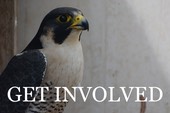Eagles and Lead
It was a long, bitter-sweet week treating two lead-poisoned Bald Eagles. The first eagle, mentioned two weeks ago in the journal, is progressing well, although once chelation therapy began it became apparent we would have a wrestling match twice a day in order to administer the treatment which is given as an intramuscular injection. We wanted to keep him as quiet as possible so the hairline fracture in his left wing would heal with cage rest.
So began the search for an oral medication that could be hidden in a piece of food. Information about DMSA (generic name Succimer) was found in an internet search. Very resourceful volunteer Toni located Malley's Compounding Pharmacy in Richland, WA. The pharmacy prepared 30 doses of the drug (enough for 3 courses of treatment) at their cost, saving BMW hundreds of dollars. The manufacturer sells the product under the name Chemet for $1500 for 100 capsules! Thank you Malley's!
The second Bald Eagle has a very sad story. He was found near Yakima, WA, transported by WDFW to Prosser Animal Hospital where x-rays were taken determining there were no broken bones. Volunteers Dan and Claudia then transported the eagle to Umatilla where they met Bob who brought him to Pendleton. Initially, the eagle was able to stand.

A blood sample was quickly drawn. The eagle's blood lead level was literally off the chart, requiring the sample be diluted and the test run again. The result: 261 micrograms/deciliter, more than 10 times the lead level of the first eagle. The eagle was critically ill. With help from consulting veterinarian Dr. Jeff Cooney, we aggressively started chelation therapy. In 48 hours the blood lead level dropped to 95, still highly toxic, but an amazing improvement.
Chelation only removes lead in the blood. It cannot reach lead deposited in other body tissues. The lead was causing the eagle to be nauseous. It also seemed to have an effect on his lungs, making it more difficult to breath each time IV fluids were administered. After 5 days the lead won and the eagle died. The photo below was taken less than an hour before he died. He is being given supplemental oxygen.

The most common source of lead toxicity in eagles and other wildlife in the Pacific Northwest are animals that have been shot with lead ammunition. Lead affects three major organ systems: the central and peripheral nervous systems, the pathway involving the manufacture of red blood cells and the kidneys. Children are more sensitive than adults to the neurocognitive (brain) and behavioral effects of lead. Permanent cognitive deficits have been found in children with lead levels of less than 7.5 micrograms/dl. There is likely no safe level of lead. If you hunt game animals with lead ammunition and eat the meat, you are likely consuming small amounts of lead.
Please, help save your children and wildlife, spread the word: Hunt Lead-Free.







